Dropshipping pet products eliminates the need for inventory management, allowing retailers to sell items directly from suppliers with minimal upfront costs. Wholesale requires purchasing bulk stock, which involves higher initial investments but typically offers better profit margins. Choosing between dropshipping and wholesale depends on your risk tolerance, capital availability, and desire for control over inventory and fulfillment.
Table of Comparison
| Feature | Dropshipping | Wholesale |
|---|---|---|
| Inventory | No need to hold stock; suppliers ship directly | Requires purchasing and storing inventory |
| Startup Costs | Low initial investment | Higher upfront capital required |
| Profit Margins | Lower margins due to middlemen | Higher profit margins possible |
| Risk | Lower financial risk; no stock ownership | Higher risk from unsold inventory |
| Shipping Control | Limited control, relies on supplier speed | Full control over packaging and shipping |
| Order Volume | Suitable for smaller order volumes | Best for bulk orders and scale |
| Customer Service | Dependent on supplier responsiveness | Direct control over customer experience |
Understanding Dropshipping and Wholesale: Key Differences
Dropshipping allows retailers to sell products without holding inventory, shipping items directly from suppliers to customers, whereas wholesale requires purchasing bulk stock upfront and managing storage. Key differences include investment cost, inventory risk, and control over shipping processes. Dropshipping offers lower financial risk but less profit margin, while wholesale demands higher capital with potential for greater margins.
Business Models Compared: Dropshipping vs Wholesale
Dropshipping involves selling products directly from suppliers to customers without holding inventory, minimizing upfront costs and reducing risk, whereas wholesale requires purchasing bulk inventory for resale, leading to higher initial investment but greater control over stock and pricing. Dropshipping offers flexibility and lower operational expenses, making it suitable for startups, while wholesale demands storage space and inventory management but provides higher profit margins per unit. Comparing business models, dropshipping emphasizes ease of entry and scalability, while wholesale focuses on inventory ownership and potential for long-term growth.
Startup Costs: Which Model is More Affordable?
Dropshipping requires significantly lower startup costs compared to wholesale since it eliminates the need for inventory purchase and warehousing expenses. Wholesale demands upfront investment in bulk inventory and storage, increasing initial financial risk for new entrepreneurs. For budget-conscious startups, dropshipping offers a more affordable and flexible model to enter the e-commerce market.
Inventory Management: Dropshipping vs Wholesale
Dropshipping eliminates the need for inventory management by allowing retailers to sell products without holding stock, as suppliers handle storage and shipping directly. In contrast, wholesale requires businesses to purchase, store, and manage inventory, demanding upfront investment in warehousing and stock control. Efficient inventory management in wholesale involves forecasting demand accurately to avoid overstocking or stockouts, whereas dropshipping transfers these risks to the supplier.
Order Fulfillment Process: Efficiency and Control
Dropshipping streamlines order fulfillment by outsourcing inventory storage and shipping to suppliers, enabling faster scalability with minimal upfront investment. Wholesale requires merchants to handle inventory management and shipping logistics, offering greater control but increased operational complexity. Choosing between these models depends on prioritizing efficiency in order processing versus maintaining direct oversight of product handling.
Profit Margins: Analyzing Earnings Potential
Dropshipping typically offers lower profit margins ranging from 10% to 30% due to higher per-unit costs and reliance on third-party suppliers. Wholesale purchasing involves bulk buying at significantly reduced costs, enabling profit margins of 30% to 60% but requiring larger upfront investment and inventory management. Analyzing earnings potential reveals that wholesale allows higher profitability with increased operational risks, whereas dropshipping provides lower margins with minimal financial risk and inventory burden.
Scalability and Growth Opportunities
Dropshipping offers higher scalability due to low upfront inventory costs and the ability to quickly add new products without significant capital investment. Wholesale requires bulk purchasing and storage, limiting flexibility but potentially yielding higher profit margins per sale. Growth opportunities in dropshipping hinge on efficient supplier relations and marketing, while wholesale growth depends on managing inventory and optimizing supply chain logistics.
Supplier Relationships: Challenges and Strategies
Dropshipping supplier relationships often face challenges such as limited control over inventory and shipping times, requiring clear communication and reliable partnerships to ensure product quality and timely delivery. Wholesale suppliers typically allow for more direct control, enabling businesses to manage stock levels and customize orders but demand larger upfront investments and storage capabilities. Effective strategies include regularly vetting suppliers, negotiating transparent terms, and leveraging technology for real-time inventory tracking to optimize supply chain efficiency.
Risks and Common Pitfalls in Each Model
Dropshipping exposes entrepreneurs to higher risks of supplier reliability issues, delayed shipping, and limited control over product quality, often leading to customer dissatisfaction and increased returns. Wholesale requires significant upfront investment and inventory management, with risks including overstocking, storage costs, and potential obsolescence of products. Both models face challenges in maintaining competitive pricing, managing supplier relationships, and handling customer service effectively to sustain profitability.
Choosing the Right Model for Your Business
Dropshipping enables entrepreneurs to sell products without holding inventory, reducing upfront costs and risks, while wholesale requires bulk purchasing and storage but offers higher profit margins per unit. Selecting the right model depends on factors like startup capital, storage capacity, cash flow, and control over shipping and branding. Businesses prioritizing low investment and flexibility often prefer dropshipping, whereas those seeking higher margins and scalability may find wholesale more advantageous.
Dropshipping vs Wholesale Infographic

 bizdif.com
bizdif.com